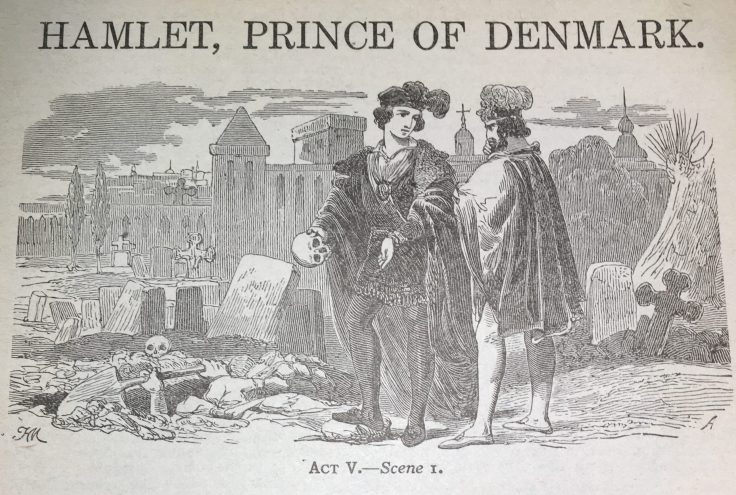It is hard to say with confidence which William Shakespeare play was most popular during his lifetime, but it may have been Henry IV, Part 1, which was published more than any other, followed by Richard III. During the Shakespeare revival in the 18th century, it was probably Henry VI, also Part 1, followed once again by Richard III and Romeo and Juliet, which took the 1748-49 season by storm. Today it is probably Hamlet, with MacBeth, Romeo and Juliet, and Julius Caesar fighting it out for second.
Hamlet is sometimes called Shakespeare’s most modern play and has been the subject of widely differing interpretations. Unsurprisingly, Freud thought it was a play about a man who wanted to sleep with his mother and who sublimated this desire by killing his uncle. For Terry Eagleton, Hamlet is about a man who rejects the old aristocratic order and attempts, tragically, to live outside it. For Harold Bloom, it is a play about human subjectivity.
All of these interpretations are maddeningly wrong, Gideon Rappaport argues in his heavily annotated edition of the play, which also includes a substantial introduction. "Hamlet is not a man who thinks too much," Rappaport writes, "or one who is too melancholy, or too passionate, or too rational, or too cowardly, or existentialist, or nihilistic, or in love with his mother, or conflicted about whether he is a scholar or a soldier, or clinically suicidal." It is, rather, a "spiritual drama" about "the human being’s right relation to the divine and to the morally complex world we all inhabit."
Rappaport reminds us that Hamlet was clearly modeled on Thomas Kyd’s popular Spanish Tragedy, which was performed as early as 1592 and probably earlier. In Kyd’s play, avenging a wrong is a simple point of honor, but in Hamlet, it is more complex. The play asks how "the traditional aristocratic honor code, which commanded victims of unpunished crimes to seek revenge," can "be squared with revealed Christian doctrine, which proclaims that vengeance belongs only to God."
But the play asks more than this, for "in the guise of a revenge play," Rappaport writes, "Shakespeare has taken for his real subject the whole paradoxical condition of man. How can we do the right thing when the right thing is not clear, when our passions and our reason move us in contrary directions, and when one wrong move, arising from a mere ‘dram of evil,’ could land us in hell."
The play opens with the ghost of Hamlet’s father commanding his son to avenge his "most foul and most unnatural murder" and, at the same time, to "Taint not thy mind." He is commanded, in short, to bring justice and to do so without sin. The action that follows stems directly from this double command—Hamlet’s feigning madness to buy time and the performance of The Mousetrap to "catch the conscience" of Claudius and, therefore, confirm that the ghost was indeed from God and not a devil.
Yet, in the key scene, which is not Hamlet’s "To be or not to be" soliloquy, Rappaport argues, but when Claudius appears to be confessing his sin in the chapel, Hamlet fails to act. To kill Claudius in the middle of his confession would send him straight to heaven, or so Hamlet thinks, and he wants to catch Claudius in some sin and send him to hell. Hamlet has overstepped his bounds. He wants to be both God and God’s executioner, and so chooses not to kill Claudius when providence had delivered him into his hand.
What follows, of course, is the unravelling of the Danish court. Hamlet kills Polonius, Claudius’s adviser, mistaking him for Claudius, and is sent to England to be executed. When Hamlet escapes and returns home, he kills Claudius but dies as well, along with his mother and Polonius’s son, Laertes. No one is left to rule Denmark, and Fortinbras, the crown prince of Norway, steps in to fill the void at the play’s conclusion. The play shows, Rappaport argues, that "the good reputation of a generally good man, like that of a nation, might be ruined for a single fault."
Rappaport’s reading of the play is not new, but it is sorely needed as adaptations of the play have become increasingly bizarre. One recent adaption made Hamlet gender-fluid. In her 2016 production of the play, Patricia MacGregor cast Chuk Iwuji as a proto-Black Lives Matter protester.
In his introduction, Rappaport provides a helpful analysis of Hamlet’s soliloquies, showing how Hamlet uses "false reasoning" in the service of "a corrupt will." While his exhaustive annotations on the text will be cumbersome for most readers (they are often longer than the text itself), teachers and performers of the play will find them invaluable. He reminds us, for example, that while Hamlet’s "To be or not to be" soliloquy is "a profound speech," "it would be a deformation of the play to take it as the expression of the play’s essence."
Shakespeare speaks to us most powerfully in the play’s quieter moments, which is yet another reminder that the smallest things matter—and sometimes matter most.
William Shakespeare’s Hamlet
edited and annotated by Gideon Rappaport
One Mind Press, 402 pp., $48
Micah Mattix, a professor of English at Regent University, has written for the Wall Street Journal and many other publications.
